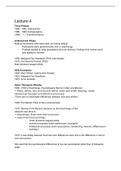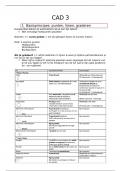Lecture 4
Three Phases
1886 - 1960: Androcentric
1960 - 1990: Compensatory
1990 - → : Transformative
Androcentric Phase
Male as Normative, Men were seen as normal default
- Participants were predominantly men in psychology
- Findings applied to other populations (but not reverse); findings from women were
only applied to women
1894: Margaret Floy Washburn (PhD, first female)
1933: Inez Beverly Prosser (PhD)
Ruth Winifred Howard (PhD)
APA Presidents:
1905: Mary Whiton Calkins (first female)
1932: Margaret Floy Washburn
1972: Anne Anastasi
Helen Thompson Woolley
1900 - PhD in Psychology: Psychological Norms in Men and Women
→ Motor ability, skin and muscle sense, taste and smell, hearing, vision,
intellectual faculties and affective processes
“There are no meaningful differences between men and women.”
1903: The Mental Traits of Sex (controversial)
1910: Review of the Recent Literature on the Psychology of Sex
research was done in:
→ physiology: Brain-size and structures
→ experimental psychology
- motor functions (tapping tests)
- sensory processes (color preferences, boys/girls)
- intellectual processes (word associations, handwriting, memory, differences in
activities)
1910: It was widely believed that brain size differences were due to the difference in size of
men and women.
She said that the psychological differences of sex are sociological rather than of biological
origin.
, “The world at large is quite agreed that women are to a greater extent than men dominated
by emotions, though the only direct experimental evidence does not support this view, and it
is hard to reconcile with the attributes of patience, self-control, and power to endure pain,[...]
which are also ascribed to women.”
Compensatory Phase
Gender = way of identifying in a social context
Was introduced in 1955 by John Money, appreciated and hated
1960’s: Second Wave of feminism; Vietnam war protests; Stonewall Riots; Civil Rights
movement
1963: Federal Equal Pay Act (USA)
1966: National Organization for Women
1969: Association for Women inPsychology (not part of APA)
1973: Division of the Psychology of Women (APA)
Compensatory Activities:
1. Focus on “foremothers” of Psychology (barriers: gatekeepers, financial resources,
social norms)
2. “Woman as problem”: Explanation of differences or “deficiencies” through roles and
expectations (sexism as interpersonal attitudes, influence of sex on evaluation,
intrapersonal characteristics); rather to look at woman as the problem, the
perspective shifted to the environment and the way that social roles were causing
harm to women.
3. Shift from “women” to “doing gender”
4. Transformation: self-reflective challenging of assumptions and practices in the field
Transformational Phase
1991: Anita Hill’s testimony (Third-Wave feminism)
Intersectionality (1989) = the ways in which systems of inequality based on gender, race,
ethnicity, sexual orientation, gender identity, disability, class and other forms of
discrimination “intersect” to create unique dynamics and effects. (Kimberlé Crenshaw)
2021: APA opposed “reparative” or conversion “therapy” for trans- people. It is no longer
ethical to put people in a box of their sex.
It is now a generally accepted belief that the smaller gross weight of the female brain has no
significance other than that of the smaller average size of the female. With regard to the
other anatomical characters enumerated, Dr. Mall shows that those observers who have
found differences in characteristics of sex have been guilty of serious errors in scientific
procedure.
Heterosexism
heterosexual assumption = all people are presumed to be heterosexual, and heterosexual
behavior and different sex relationships are considered normal, natural and unproblematic.






